11.5 Characteristics of the SN1 Reaction
Just as the SN2 reaction is strongly influenced by the structure of the substrate, the leaving group, the nucleophile, and the solvent, the SN1 reaction is similarly influenced. Factors that lower ∆G‡, either by lowering the energy level of the transition state or by raising the energy level of the ground state, favor faster SN1 reactions. Conversely, factors that raise
∆G‡, either by raising the energy level of the transition state or by lowering the energy level of the reactant, slow down the SN1 reaction.
The Substrate
According to the Hammond postulate (Section 7.10), any factor that stabilizes a high- energy intermediate also stabilizes the transition state leading to that intermediate. Because the rate-limiting step in an SN1 reaction is the spontaneous, unimolecular dissociation of the substrate to yield a carbocation, the reaction is favored whenever a stabilized carbocation intermediate is formed. The more stable the carbocation intermediate, the faster the SN1 reaction.
We saw in Section 7.9 that the stability order of alkyl carbocations is 3° > 2° > 1° > methyl. To this list we should also add the resonance-stabilized allyl and benzyl cations. Just as allylic radicals are unusually stable because the unpaired electron can be delocalized over an extended π orbital system (Section 10.4), so allylic and benzylic carbocations are unusually stable. (The word benzylic means “next to an aromatic ring.”) As Figure 11.13 indicates, an allylic cation has two resonance forms. In one form, the double bond is on the “left”; in the other form it’s on the “right.” A benzylic cation has five resonance forms, all of which contribute to the overall resonance hybrid.
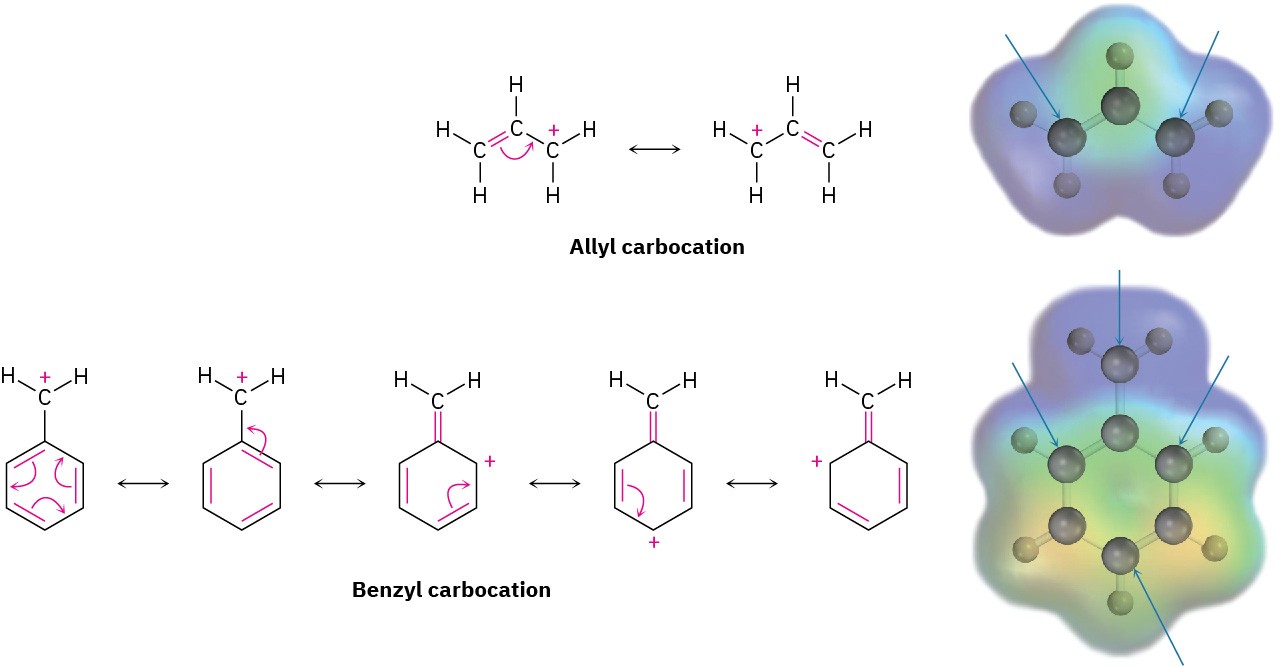
Figure 11.13 Resonance forms of allylic and benzylic carbocations. The positive charge is delocalized over the π system in both. Electron-poor atoms are indicated by blue arrows.
Because of resonance stabilization, a primary allylic or benzylic carbocation is about as stable as a secondary alkyl carbocation, and a secondary allylic or benzylic carbocation is about as stable as a tertiary alkyl carbocation. This stability order of carbocations is the same as the order of SN1 reactivity for alkyl halides and tosylates.

We should also note parenthetically that primary allylic and benzylic substrates are particularly reactive in SN2 reactions as well as in SN1 reactions. Allylic and benzylic C–X bonds are about 50 kJ/mol (12 kcal/mol) weaker than the corresponding saturated bonds and are therefore more easily broken.

Problem 11-11
Rank the following substances in order of their expected SN1 reactivity:

Problem 11-12
3-Bromo-1-butene and 1-bromo-2-butene undergo SN1 reaction at nearly the same rate, even though one is a secondary halide and the other is primary. Explain.
The Leaving Group
We said during the discussion of SN2 reactivity that the best leaving groups are those that are most stable; that is, those that are the conjugate bases of strong acids. An identical reactivity order is found for the SN1 reaction because the leaving group is directly involved in the rate-limiting step. Thus, the SN1 reactivity order is

Note that in the SN1 reaction, which is often carried out under acidic conditions, neutral water is sometimes the leaving group. This occurs, for example, when an alkyl halide is prepared from a tertiary alcohol by reaction with HBr or HCl (Section 10.5). As shown in Figure 11.14, the alcohol is first protonated and then spontaneously loses H2O to generate a carbocation, which reacts with halide ion to give the alkyl halide. Knowing that an SN1 reaction is involved in the conversion of alcohols to alkyl halides explains why the reaction works well only for tertiary alcohols. Tertiary alcohols react fastest because they give the most stable carbocation intermediates.
Figure 11.14 MECHANISM
The mechanism of the SN1 reaction of a tertiary alcohol with HBr to yield an alkyl halide. Neutral water is the leaving group (step 2).
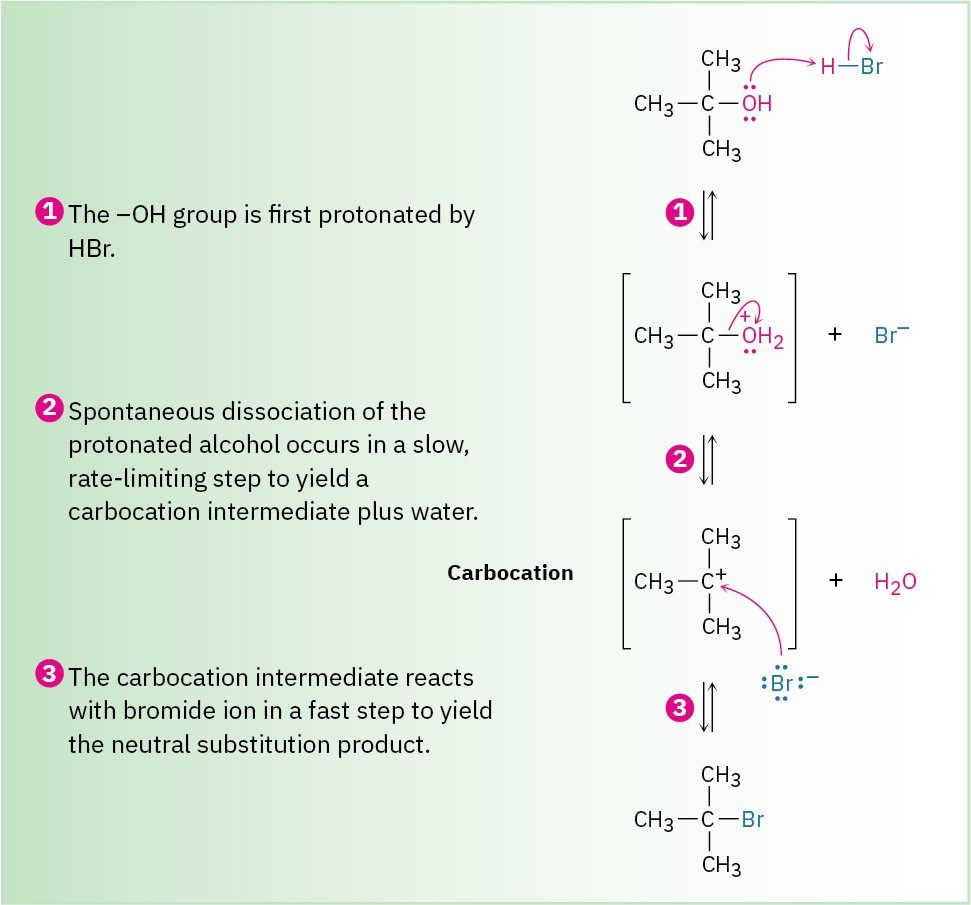
The Nucleophile
The nature of the nucleophile plays a major role in the SN2 reaction but does not affect an SN1 reaction. Because the SN1 reaction occurs through a rate-limiting step in which the added nucleophile has no part, the nucleophile can’t affect the reaction rate. The reaction of 2-methyl-2-propanol with HX, for instance, occurs at the same rate regardless of whether X is Cl, Br, or I. Furthermore, neutral nucleophiles are just as effective as negatively charged ones, so SN1 reactions frequently occur under neutral or acidic conditions.

The Solvent
What about the solvent? Do solvents have the same effect in SN1 reactions that they have in SN2 reactions? The answer is both yes and no. Yes, solvents have a large effect on SN1 reactions, but no, the reasons for the effects on SN1 and SN2 reactions are not the same.
Solvent effects in the SN2 reaction are due largely to stabilization or destabilization of the nucleophile reactant, while solvent effects in the SN1 reaction are due largely to stabilization or destabilization of the transition state.
The Hammond postulate says that any factor stabilizing the intermediate carbocation should increase the rate of an SN1 reaction. Solvation of the carbocation—the interaction of the ion with solvent molecules—has such an effect. Solvent molecules orient around the carbocation so that the electron-rich ends of the solvent dipoles face the positive charge (Figure 11.15), thereby lowering the energy of the ion and favoring its formation.
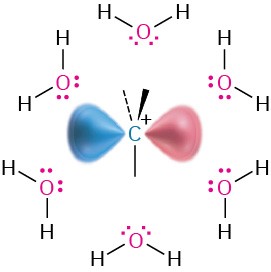
Figure 11.15 Solvation of a carbocation by water. The electron-rich oxygen atoms of solvent molecules orient around the positively charged carbocation and thereby stabilize it.
The properties of a solvent that contribute to its ability to stabilize ions by solvation are related to the solvent’s polarity. SN1 reactions take place much more rapidly in strongly polar solvents, such as water and methanol, than in less polar solvents, such as ether and chloroform. In the reaction of 2-chloro-2-methylpropane, for example, a rate increase of 100,000 is observed upon going from ethanol (less polar) to water (more polar). The rate increases when going from a hydrocarbon solvent to water are so large they can’t be measured accurately.
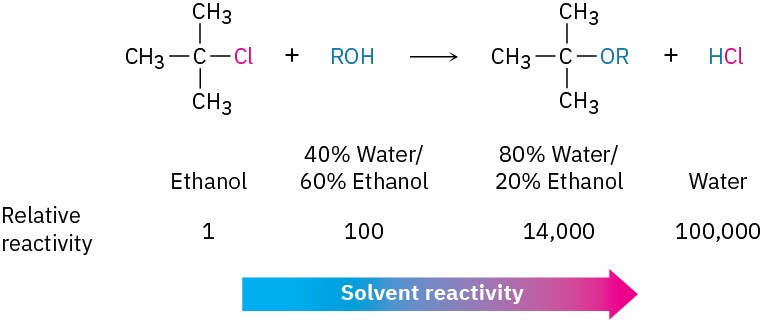
It should be emphasized again that both the SN1 and the SN2 reaction show solvent effects, but that they do so for different reasons. SN2 reactions are disfavored in protic solvents because the ground-state energy of the nucleophile is lowered by solvation. SN1 reactions are favored in protic solvents because the transition-state energy leading to carbocation intermediate is lowered by solvation.
A Summary of SN1 Reaction Characteristics
The effects on SN1 reactions of the four variables—substrate, leaving group, nucleophile, and solvent—are summarized in the following statements:
|
Substrate |
The best substrates yield the most stable carbocations. As a result, SN1 reactions are best for tertiary, allylic, and benzylic halides. |
|
Leaving group |
Good leaving groups increase the reaction rate by lowering the energy level of the transition state for carbocation formation. |
|
Nucleophile |
The nucleophile must be nonbasic to prevent a competitive elimination of HX (Section 11.7), but otherwise does not affect the reaction rate. Neutral nucleophiles work well. |
|
Solvent |
Polar solvents stabilize the carbocation intermediate by solvation, thereby increasing the reaction rate. |
Worked Example 11.2Predicting the Mechanism of a Nucleophilic Substitution ReactionPredict whether each of the following substitution reactions is likely to be SN1 or SN2:
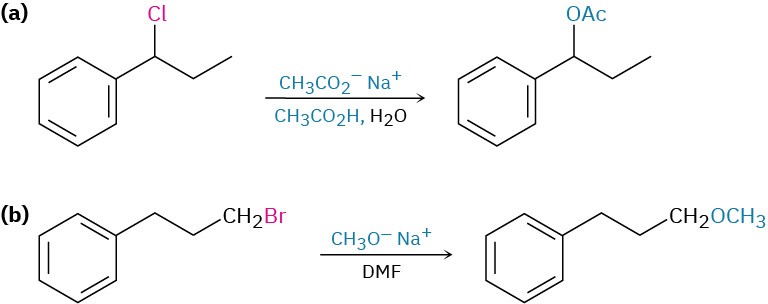 StrategyLook at the substrate, leaving group, nucleophile, and solvent. Then decide from the summaries at the ends of Section 11.3 and Section 11.5 whether an SN1 or an SN2 reaction is favored. SN1 reactions are favored by tertiary, allylic, or benzylic substrates, by good leaving groups, by nonbasic nucleophiles, and by protic solvents. SN2 reactions are favored by primary substrates, by good leaving groups, by good nucleophiles, and by polar aprotic solvents.
StrategyLook at the substrate, leaving group, nucleophile, and solvent. Then decide from the summaries at the ends of Section 11.3 and Section 11.5 whether an SN1 or an SN2 reaction is favored. SN1 reactions are favored by tertiary, allylic, or benzylic substrates, by good leaving groups, by nonbasic nucleophiles, and by protic solvents. SN2 reactions are favored by primary substrates, by good leaving groups, by good nucleophiles, and by polar aprotic solvents.
SolutionThis is likely to be an SN1 reaction because the substrate is secondary and benzylic, the nucleophile is weakly basic, and the solvent is protic.This is likely to be an SN2 reaction because the substrate is primary, the nucleophile is a good one, and the solvent is polar aprotic.
Problem 11-13
Predict whether each of the following substitution reactions is likely to be SN1 or SN2: (a)

(b)


